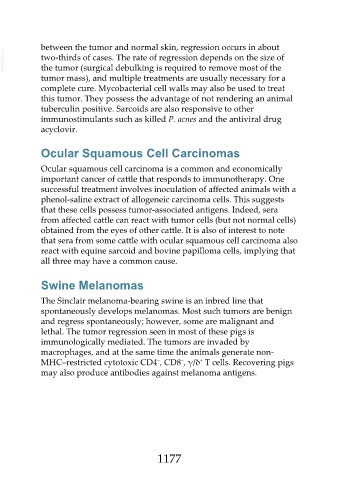Page 1177 - Veterinary Immunology, 10th Edition
P. 1177
between the tumor and normal skin, regression occurs in about
VetBooks.ir two-thirds of cases. The rate of regression depends on the size of
the tumor (surgical debulking is required to remove most of the
tumor mass), and multiple treatments are usually necessary for a
complete cure. Mycobacterial cell walls may also be used to treat
this tumor. They possess the advantage of not rendering an animal
tuberculin positive. Sarcoids are also responsive to other
immunostimulants such as killed P. acnes and the antiviral drug
acyclovir.
Ocular Squamous Cell Carcinomas
Ocular squamous cell carcinoma is a common and economically
important cancer of cattle that responds to immunotherapy. One
successful treatment involves inoculation of affected animals with a
phenol-saline extract of allogeneic carcinoma cells. This suggests
that these cells possess tumor-associated antigens. Indeed, sera
from affected cattle can react with tumor cells (but not normal cells)
obtained from the eyes of other cattle. It is also of interest to note
that sera from some cattle with ocular squamous cell carcinoma also
react with equine sarcoid and bovine papilloma cells, implying that
all three may have a common cause.
Swine Melanomas
The Sinclair melanoma-bearing swine is an inbred line that
spontaneously develops melanomas. Most such tumors are benign
and regress spontaneously; however, some are malignant and
lethal. The tumor regression seen in most of these pigs is
immunologically mediated. The tumors are invaded by
macrophages, and at the same time the animals generate non-
−
+
−
MHC–restricted cytotoxic CD4 , CD8 , γ/δ T cells. Recovering pigs
may also produce antibodies against melanoma antigens.
1177

